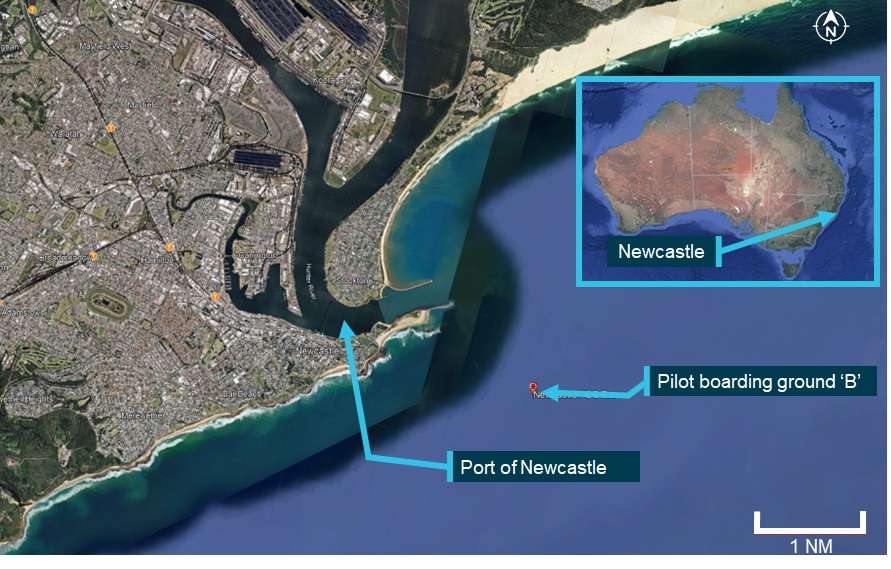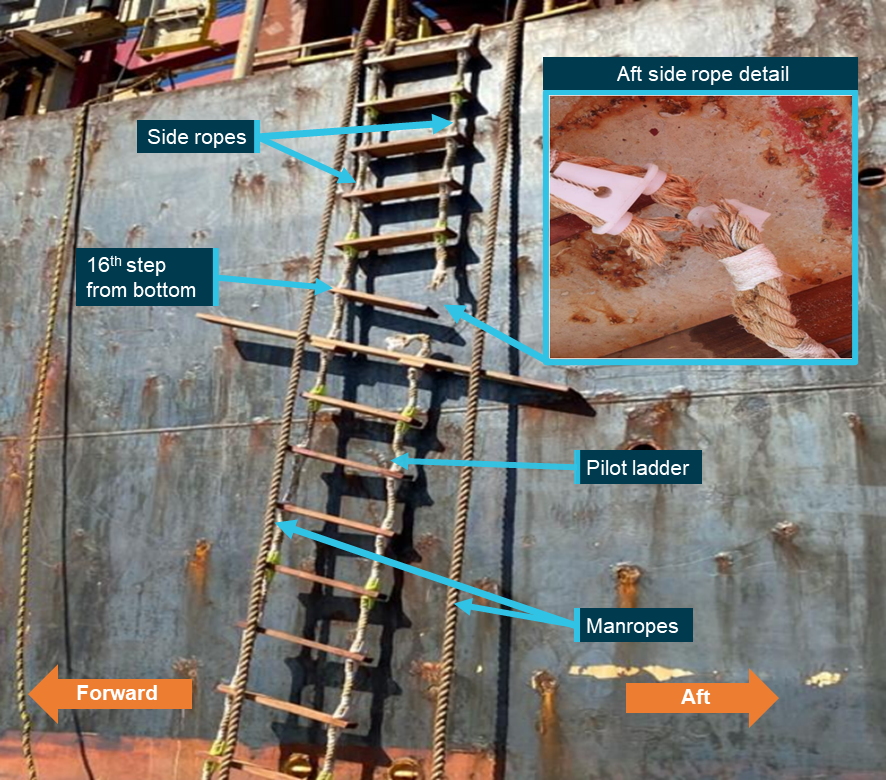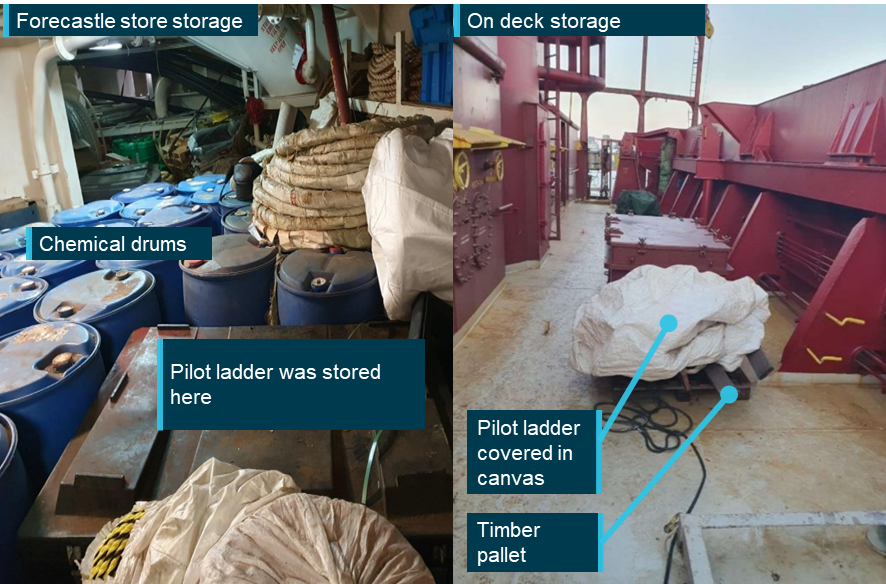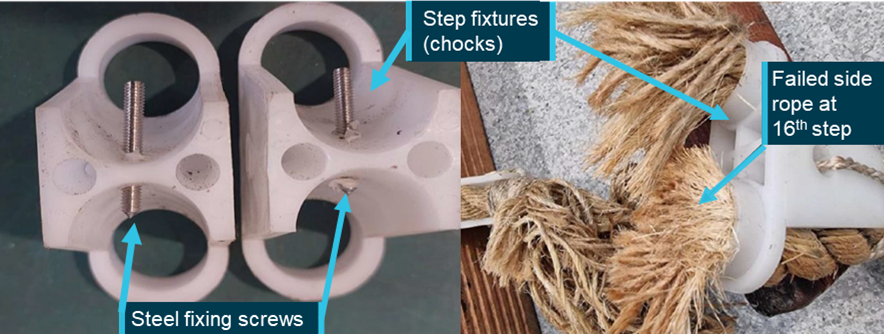What happened
At about 1620 local time on 6 February 2025, a bulk carrier vessel arrived at Newcastle pilot boarding ground Bravo, New South Wales (Figure 1) from Rayong, Thailand to board a harbour pilot for the inbound transit to M4 berth. In accordance with the pilot’s requirement, the ship’s crew prepared the pilot ladder on the port side, positioned 2 m above the water line, with 2 manropes[1] also rigged.
Figure 1: Port of Newcastle

Source: Google Earth, annotated by the ATSB
A few minutes later, the pilot vessel arrived at the pilot boarding ground. It was an approximately 8 m climb[2] from the pilot vessel to the ship’s main deck. As the pilot started ascending the pilot ladder, the aft side rope of the pilot ladder parted at the sixteenth step (Figure 2).
Figure 2: Failed pilot ladder with close-up detail

Source: Vessel operator, annotated by the ATSB
The pilot managed to support their weight with their arms and quickly moved to the step above and then onto the main deck of the vessel without injury. The pilot reported the matter to the ship’s master, who was conning[3] the vessel from the wheelhouse. On completion of the primary task of the inbound pilotage, and once the ship had been safely made fast alongside its berth, the master and pilot inspected the pilot ladder. The matter was also reported to the Australian Maritime Safety Authority (AMSA).
Pilot ladder particulars
The pilot ladder was 9 m in length and comprised 27 steps. It was supplied to the vessel on 1 February 2024 and accompanied by a certificate indicating a manufacture date of 15 January 2024. The certificate also stated that the pilot ladder complied with the following standards:
- EU Regulation 2023/1667, item no. MED/4.49
- SOLAS 74 as amended, regulation V/23 and X/3
- IMO Resolution A.1045(27)
- IMO MSC.1/Circ.1428
- ISO 799-1.
On board storage
At the time of receipt, the pilot ladder was maintained in the ship’s spare inventory and was stored in the forecastle store, in the immediate vicinity of several sealed drums containing corrosive chemicals intended for cargo hold cleaning operations.
In order to be put into service, the ladder was removed from storage on 14 January 2025, covered with canvas and placed on top of a timber pallet on the ship’s main deck, pending its use during pilot boarding operations (Figure 3).
Figure 3: Pilot ladder onboard storage arrangements

Source: Vessel’s operator, annotated by the ATSB
Prior to the ladder’s first use at the port of Newcastle on 6 February 2025, the ship’s crew reported they undertook a visual and limited physical examination of the ladder.
Operator’s investigation
Following the incident, the damaged pilot ladder was sent to an independent testing facility in Brisbane, Queensland for failure analysis. The investigation identified the following:
- the manila side rope had degraded due to several factors, including pre-existing damage, poor quality rope, chlorine contamination, and improper storage
- at the time of inspection, the ladder did not comply with the breaking strength requirement of the ISO 799-1:2019(E) standard
- the step fixtures (chocks) had steel fixing screws embedded within, which appeared to have chafed against the side ropes
- the most severe failure occurred at the sixteenth step from the bottom of the ladder, where the rope had parted completely – this was where a steel fixing screw had been embedded (Figure 4)
- a partial failure occurred between steps 22 and 23, where one of the 2 supporting ropes had broken
- minor failures of the side rope occurred throughout the ladder, primarily where securing steel screws were embedded in the plastic components
- moisture retention and significant chlorine contamination[4] of the rope fibres
- corrosion deposits on the maker’s steel identification plate that was affixed to the ladder’s step.
Figure 4: Step fixtures with steel fixing screws embedded

Source: Vessel operator, annotated by the ATSB
Safety action
The vessel’s operators have implemented the following safety actions to prevent recurrence of such incidents:
- A fleet-wide safety bulletin and circular have been issued, highlighting the precautions of pilot ladder use and mandating the immediate use of ladders from a globally reputed manufacturer.
- The company's safety management system procedure for maintaining pilot boarding arrangements was updated to include instructions on proper storage of pilot ladders to prevent their degradation.
- Fleet-wide changes to the planned maintenance system mandating the inspection, maintenance and storage of in-use and spare pilot ladders.
- Pre-joining briefing of shipboard management personnel, emphasising safe pilot boarding arrangements.
- Fleet-wide dissemination of this incident’s findings.
Safety message
Pilot ladders are typically manufactured from manila rope, which is a natural fibre. While natural fibre ropes have properties that make them ideal for use in many marine applications, they are also susceptible to damage and loss of strength from UV exposure, dirt and chemicals. Rope ladders should be adequately covered and not be stored together with acids, detergents or paint as these products and their fumes may cause the fibres to deteriorate prematurely.
Vessel operators and crew should not assume that new and unused rope ladders will be free from damage. Although the surface of the rope may appear to be in satisfactory condition, natural fibre ropes can self-abrade from the inside. It is therefore essential to open the lay of the ropes and check the strands for any internal deterioration. Regular onboard inspections, comprising visual and physical examinations, are required to ensure that the ladders are stored and maintained in a suitable environment.
Ideally rope ladders should be stored in a cool, dry and well-ventilated compartment, or if kept on the exposed deck area of ships, ranged at regular intervals to facilitate drying between uses.
Marine Notice 04/2023[5] provides guidance on pilot transfer arrangements and highlights the issues due to regular non-compliance with these arrangements. The notice stated that since November 2017, multiple separate incidents involving the failure of a pilot ladder securing point or manropes had been reported.
The International Maritime Organization Sub-Committee on Navigation, Communications and Search and Rescue (NCSR) finalised the draft amendments to SOLAS Regulation V/23 and associated instruments to improve the safety of pilot transfer arrangements. These amendments are expected to enter into force from 1 January 2028. Vessel operators and managers are urged to heed the relevant requirements and, where possible, implement the measures on a proactive basis.
About this report
Decisions regarding whether to conduct an investigation, and the scope of an investigation, are based on many factors, including the level of safety benefit likely to be obtained from an investigation. For this occurrence, no investigation has been conducted and the ATSB did not verify the accuracy of the information. A brief description has been written using information supplied in the notification and any follow-up information in order to produce a short summary report, and allow for greater industry awareness of potential safety issues and possible safety actions.
[1] Manropes are 2 ropes of not less than 28 mm and not more than 32 mm diameter secured to the ship in addition to the pilot ladder if required by the pilot. They are placed either side of the pilot ladder and fixed at the rope end to a ring plate fixed on the ship’s deck.
[2] The ship’s freeboard was reported as 7.8 m and therefore a combination ladder (pilot ladder used in conjunction with accommodation ladder) was not required.
[3] The act of controlling or commanding a ship.
[4] In addition to potential saltwater exposure while stored on deck, the ladder was stored in an environment exposed to chemical mixtures comprising hydrochloric acid in the forecastle store for approximately one year.


